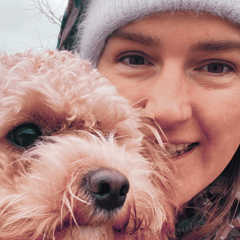

Hilary Cluett • June 2025
Whenever I begin a project, I start with small, inexpensive attempts and experiments, allowing me to feel comfortable with the possibility of failure, learn from it, and adapt the process.
To bring that mentality into cross-collaborative designs, I take one step at a time. Instead of sharing a grand idea and project, I start with one group task, followed by another.
At each stage, I ask questions, test ideas, and use simple tools to plan and create prototypes of products or services (or mock-ups and maps) that benefit both the business and its clients or customers.
There are infinite maps you can create, but today, I will explain a straightforward, detailed journey map focused on one scenario of the internal team’s journey: getting involved in a cross-functional design process
In our scenario, the actor is the group or team of cross-collaborative experts. The map is from their perspective and focuses on their experience.
In this case, the map will examine the initial onboarding of a cross-functional team. What is the employee’s experience before joining the team and during onboarding?
We established two stages: pre-onboarding and onboarding. In the pre-onboarding stage, there are multiple steps because each step involves any experience they might have, including interactions with other people, external training, credentials, personality types, and professional expertise. The list goes on and on. In the onboarding stage, there are multiple steps, including introductory meetings, surveys and questionnaires about knowledge and opinions, setting expectations, determining the frequency of commitments and availability, and ensuring a sense of safety and welcome, among others.
Using a storyboard, we could draw out each step of the stages. Each participant can have a bubble of their external training and credentials above their head, and we show them interacting together, possibly with some question marks of confusion, as we illustrate different personality types and professions trying to get along. Then, in the onboarding stage, draw those same participants around a giant heart with a clock in the center to show that onboarding means respecting the person, time, and opinion. The goal is to empathize with the actors and navigate quickly between stages.
There are two options here. First, based on your best guess, you assume you know what someone might be feeling. Second, you ask a real person in that situation how they feel and use real data. The more accurate you are, the better your map will represent the actor’s experience. If you do not have a team to survey, find a cross-functional team and ask its members to rate their satisfaction at each step, using a scale from -2 (very negative) to +2 (very positive). The numbers will reveal any problems within an experience.
List the channels you use to communicate with the actor at each step, such as e-mail, memos, direct messages, and video conferences. These lists provide a comprehensive overview of cross-channel experiences, offering guidance on adjusting communication styles.
At each step, list which stakeholder is responsible for what part of the task to identify potential players to include as you implement this process.
Again, go back and interview your group, asking them to rate their engagement at each step on a scale of 1 (very low) to 5 (very high). The engagement curve will reveal a dramatic arc in the pace and rhythm of the experience.
List the backstage processes facilitating each step as a flowchart to reveal which departments and systems you require or trigger at specific steps.
At each step, pretend Dr. Who has travelled into the future, and he shows you that your step failed. Take two minutes for each step, and write how you failed. Then, return to reality and assess whether you have appropriate measures in place to help if something like this were to occur.
List any particular services or products (physical or digital) that help the actor achieve the steps of the stages. It might highlight ineffective tools or resources that do not provide value or uncover new opportunities.
At each step, list how many people are participating; that way, you will visualize how many conversions you have through the stages. In this scenario, you will want the same number of people who start in stage 1 to finish stage 2. If you don’t have the same number, you will see which step has them dropping off, and you can address those challenges.
I wanted to explain this example fully because often, when someone describes a journey map, you will see a random figure with lines, emojis and nonsensical data. Going into detail in our micro example allows you to apply these same methods to larger maps with a broader focus, more stages and steps, or a different group of actors.
If you would like some help doing this, book an appointment with me on any Wednesday, and I will be happy to walk you through it step by step.
About Hilary Cluett
Hilary Cluett publishes double daily newsletters on LinkedIn to discuss design, discovery, and experience and offer tools and tips for implementing wild ideas. This summer, she wants to expand her network, so please connect with her on LinkedIn. Her service poodle, Akira, and she would love to meet you.